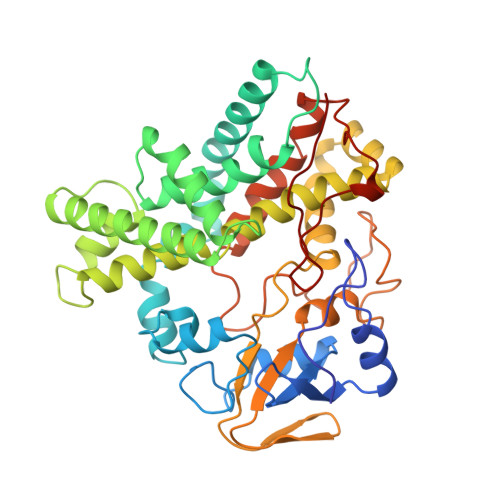Proton delivery in NO reduction by fungal nitric-oxide reductase. Cryogenic crystallography, spectroscopy, and kinetics of ferric-NO complexes of wild-type and mutant enzymes.
Shimizu, H., Obayashi, E., Gomi, Y., Arakawa, H., Park, S.Y., Nakamura, H., Adachi, S., Shoun, H., Shiro, Y.(2000) J Biological Chem 275: 4816-4826
- PubMed: 10671516
- DOI: https://doi.org/10.1074/jbc.275.7.4816
- Primary Citation of Related Structures:
1CL6, 1CMJ, 1CMN - PubMed Abstract:
Fungal nitric-oxide reductase (NOR) is a heme enzyme that catalyzes the reduction of NO to N(2)O through its ferric-NO complex, the first intermediate of the catalysis. Crystal structures of the ferric-NO forms of wild type (WT) fungal NOR, and of the Ser(286) --> Val and Ser(286) --> Thr mutant enzymes were determined to 1.7-A resolution at cryogenic temperature (100 K). This shows a slightly tilted and bent NO binding to the heme iron, in sharp contrast to the highly bent NO coordination found in ferrous hemoproteins. In the WT structure, a specific hydrogen-bonding network that connects the active site to the solvent was identified, H(2)O(Wat(74))-Ser(286)-H(2)O(Wat(33))-Asp(393)-solvent. Wat(74) is located 3.10 A from the iron-bound NO. Replacement of Ser(286) with Val or Thr scarcely alters the NO coordination structure but expels the water molecules, Wat(74) from the active site. The Asp(393) mutation does not influence the position of Wat(74), but disrupts the hydrogen-bonding network at Wat(33), as evidenced by enzymatic, kinetic, and spectroscopic (resonance Raman and IR) results. The structural changes observed upon the Ser(286) or the Asp(393) mutation are consistent with the dramatic loss of the enzymatic activity for the NO reduction of fungal NOR. We have conclusively identified the water molecule, Wat(74), adjacent to the iron-bound NO as a proton donor to the Fe-NO moiety. In addition, we find the hydrogen-bonding network, H(2)O(Wat(74))-Ser(286)-H(2)O(Wat(33))-Asp(393), as a proton delivery pathway in the NO reduction reaction by fungal NOR.
- The Faculty of Science, Gakushuin University, Mejiro, Toshima-ku, Tokyo 170-0031, Japan.
Organizational Affiliation:


















